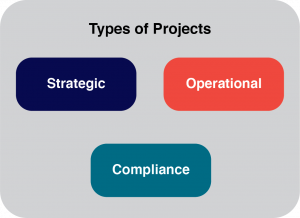1.3. Types of Projects
There are three broad categories of projects to consider: Strategic Projects, Operational Projects, and Compliance Projects (Figure 1.1).
- Strategic Projects involve creating something new and innovative. A new product, a new service, a new retail location, a new branch or division, or even a new factory might be a strategic project because it will allow an organization to gain a strategic advantage over its competitors.
- Operational Projects improve current operations. These projects may not produce radical improvements, but they will reduce costs, get work done more efficiently, or produce a higher-quality product.
- Compliance Projects must be done in order to comply with an industry or governmental regulation or standard. Often there is no choice about whether to implement a project to meet a regulation, but there may be several project options to consider, any of which would result in meeting compliance requirements.

Traditional Project Management
While project management can be traced back to the building of the Great Pyramids in Egypt, it was really in the post-WW2 industrial boom of the 1950s that project managers started to develop the tools and techniques used in modern project management. These tools were used to complete large industrial and military projects, where the scope of work (what we need to accomplish in a project) was well defined. For example, the scope of what we have to do can be planned out well when we are constructing an apartment building, making a nuclear submarine missile, or building an oil refinery.
These traditional techniques have been elaborated and standardized by organizations such as the Project Management Institute (PMI) in the US, The International Project Management Association (headquartered in Switzerland), and AXELOS (the organization behind the PRINCE2 certification used in Great Britain). These traditional techniques were also adapted to software development. Techniques such as waterfall (where phases are sequential) and function point analysis (a set of rules to measure functionality to users) were advanced as effective ways to manage software development projects. However, as the world of software development changed—from large, time-consuming projects that were loaded on mainframe computers to fast-moving, fast-changing, internet-based applications many programmers found waterfall and similar methods to be limiting. These techniques lacked flexibility and were inadequate to deal with a rapidly changing, competitive landscape. As a result, a “revolution” of sorts was mounted, and out of that revolution came several so-called Agile project management methods.
Agile Project Management
Agile is a broad term for project management techniques that are iterative in nature. Rather than trying to develop all aspects of a project or software application and then presenting that result to the customer after a long development cycle (6 to 24 months), Agile techniques use short development cycles in which features of high value are developed first and a working product/software can be reviewed and tested at the end of the cycle (20-40 days).
“1.1: Project Definitions” from Project Management Fundamentals by J Scott Christianson is licensed under a Creative Commons Attribution-NonCommercial-ShareAlike 4.0 International License.

